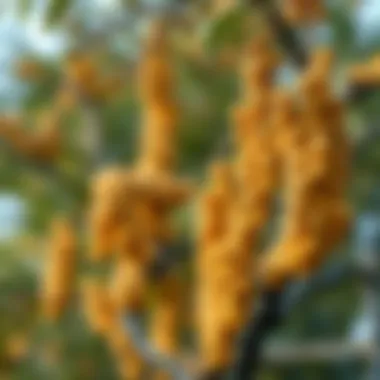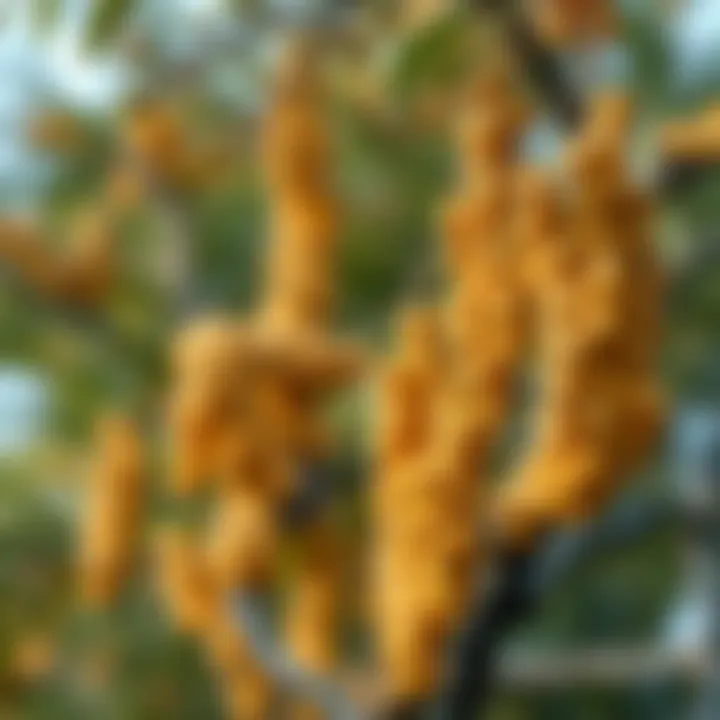Acacia Senegal: Importance and Diverse Applications


Intro
Acacia Senegal, often revered for its versatile applications and rich ecological potential, stands as a cornerstone species in many regions, predominantly in Africa. This tree species, known primarily for its production of gum arabic, holds significant relevance not just in ecological spheres but also within economic frameworks. The gum arabic derived from Acacia Senegal is utilized in food products, pharmaceuticals, and even cosmetics. However, the importance of this species extends far beyond its commercial uses. In various cultures, it symbolizes resilience and adaptability, embodying the very essence of survival in arid landscapes.
The geographical distribution of Acacia Senegal is another facet worth delving into. Predominantly found in the dry savannas of Sudan, and extending into neighboring regions, this species thrives in environments that many other plants cannot endure. Understanding the unique adaptability and resilience of Acacia Senegal helps shed light on broader ecological principles that are vital in combating sustainable land management and biodiversity loss.
As we venture deeper into the significance and applications of Acacia Senegal, we will dissect its botanical characteristics, explore its potential threats and the socio-economic impacts of its cultivation, and address future research areas. Through careful analysis, we aim to paint a comprehensive picture, highlighting not just the practical uses but also the ecological interdependence this species fosters with its environment.
"The journey of understanding Acacia Senegal is not just about its economic value but a broader appreciation of its role in maintaining ecological balance."
By synthesizing current knowledge and exploring innovative research paths, we hope to craft a narrative that empowers researchers, educators, and enthusiasts to advocate for the sustainability of Acacia Senegal.
Importance of the Study
The significance of researching Acacia Senegal cannot be overstated. It encompasses a myriad of angles:
- Ecological Importance: Its role in biodiversity and as a resource for various fauna is crucial.
- Economic Contributions: The diverse applications of gum arabic fuel local and international markets.
- Cultural Relevance: Serving as a symbol of resilience in communities where it thrives.
- Sustainability Challenges: Addressing its cultivation and the threats it faces such as climate change and over-exploitation.
With this foundation established, we are ready to embark on a thorough examination of Acacia Senegal, its applications, and the multifaceted roles it plays in our ecosystems.
Prelims to Acacia Senegal
Acacia Senegal stands at the intersection of ecological balance and economic viability, illuminating various pathways for both industries and nature enthusiasts alike. This species, renowned especially for its capacity to produce gum arabic, presents an interesting case study of how a single plant can influence diverse fields such as agriculture, industry, and environmental conservation. Understanding its significance goes beyond mere academic interest; it touches on the sustainability of ecosystems and the intricate relationships between flora and human activity.
Overview of Acacia Species
The Acacia genus comprises over 1,300 species, each exhibiting unique traits and adaptations. Acacia Senegal, in particular, belongs to the Mimosaceae family and is native to the arid regions of Africa and the Arabian Peninsula. It showcases a remarkable ability to thrive in tough environments where other vegetation struggles, thanks to its drought resistance and resilience. More than just a hardy plant, Acacia species like Senegal are vital components of their ecosystems, providing shelter and sustenance for various wildlife.
Ecological Contributions
- Biodiversity: Acacia Senegal creates habitats for numerous species, from insects to larger mammals.
- Soil Enrichment: It plays an essential role in nitrogen fixation, enhancing soil fertility, which can benefit neighboring plants and thus support a broader ecosystem.
Recognizing these features is fundamental, especially when we consider the ongoing threat to biodiversity in many regions across the globe.
Historical Context
The historical significance of Acacia Senegal cannot be understated. It has been used for centuries by indigenous communities, especially in Africa. Gum arabic, a natural gum obtained from the tree's sap, has been a trading commodity for thousands of years. It is also a key ingredient in numerous industries.
Cultural Relevance
- Indigenous tribes have traditionally harvested gum for medicinal and culinary uses, incorporating it into their daily lives. This deep-rooted relationship illustrates the cultural importance of Acacia Senegal, making it an integral part of local heritage.
- Throughout history, the gum has been exported globally, impacting trade routes and economic systems as far back as the ancient civilizations of Egypt.
In examining this historical context, one finds a tapestry of human interaction with nature that has shaped both societies and their environments over time, highlighting the continuing relevance of Acacia Senegal in today’s ecological and economic discussions.
“Acacia Senegal exemplifies the interplay between nature’s resilience and human ingenuity, weaving a narrative that transcends time and geography.”
Botanical Features
Understanding the botanical features of Acacia Senegal is crucial as they provide essential insights into its resilience, adaptability, and overall ecological value. The specifics of its taxonomy and morphological characteristics reveal not only the uniqueness of this species but also its versatile applications in various fields such as agriculture, medicine, and environmental sustainability. These features also highlight Acacia Senegal's critical role in supporting biodiversity and enhancing soil health.
Taxonomy and Classification
Acacia Senegal belongs to the family Fabaceae, which is widely known as the legume, pea, or bean family. More specifically, it is categorized under the subgenus Acacia and is often recognized for its significant economic and ecological contributions. This species is primarily found in arid and semi-arid climates, with its distribution across regions like West Africa, Sudan, and parts of the Middle East. Its classification within the complex Acacia genus, which features over a thousand species, showcases not just its biological diversity but also the intricate relationships it maintains with other flora and fauna in its environment.
Morphological Characteristics


The morphological characteristics of Acacia Senegal encompass various traits that define its physical structure and adaptation to its surroundings. These features are integral to its growth, reproduction, and its various uses.
Leaves and Foliage
The leaves of Acacia Senegal are a fascinating aspect worth noting. Instead of broad leaves, this species typically exhibits fern-like phyllodes, which play a crucial role in water conservation. The fine structure of these leaves allows for minimal water loss, thus aiding survival in harsh environments. This adaptation is particularly advantageous in preventing wilting in arid conditions, making it a popular choice in agroforestry. Moreover, these leaves can provide shade and food for various herbivores, consequently contributing to the ecosystem's equilibrium.
Flowers and Inflorescence
When it comes to flowers, Acacia Senegal showcases beautiful yellow fluffy globular clusters. These flowers are not just visually appealing but serve distinct ecological roles. They attract pollinators, which is essential for the reproductive success of the species. The scent of these flowers can be quite enticing for bees and other insects, which improves the chances of cross-pollination. As a valuable source of nectar, they also support the survival of local pollinator populations, which have seen declines in many areas due to habitat loss.
Root System
The root system of Acacia Senegal is deep and extensive, giving it a foothold in rocky and dry soils. This characteristic makes it remarkably drought-resistant, allowing it to survive where many other species cannot. The roots also enhance soil fertility through nitrogen fixation, a process where atmospheric nitrogen is converted into a usable form for plants. This not only benefits Acacia Senegal itself but also improves soil health for surrounding flora, highlighting its role in promoting biodiversity within its ecosystem.
The roots of Acacia Senegal not only ensure its survival in challenging environments but also restore and enrich the soil in which it grows.
In summary, the botanical features of Acacia Senegal illustrate its significant contributions to ecological balance and agricultural utility. By examining its taxonomy and various morphological traits, one can appreciate the adaptability and vitality of this remarkable plant species.
Geographical Distribution
Understanding the geographical distribution of Acacia Senegal is paramount. This exploration not only sheds light on where this species flourishes but also underscores the ecological and economic implications tied to its presence in specific locales. The natural habitat, coupled with cultivated regions, plays a significant role in determining the viability and productivity of Acacia Senegal. Its distribution affects factors such as biodiversity, agriculture, and local economies, making it a critical focal point in any discussion about this tree.
Natural Habitat
Acacia Senegal is native to areas characterized by arid and semi-arid climates, predominantly spread across the sub-Saharan regions of Africa. The natural habitat where it thrives is often marked by well-draining soils and seasonal rainfall between 100 to 600 millimeters. Fire is a common occurrence in these ecosystems, and intriguingly, Acacia species often adapt to these conditions. They possess thick bark that helps protect them from fire damage. Moreover, their deep root systems assist in accessing underground water, which is crucial for their survival. This unique habitat not only shelters Acacia Senegal but also fosters a variety of fauna and flora, thereby enhancing biodiversity.
Cultivation Areas
The cultivation of Acacia Senegal is vital for its economic importance, particularly in the production of gum arabic. The primary regions are:
Africa
Africa stands out as the heartland for Acacia Senegal cultivation, with countries like Sudan and Senegal being prominent producers. The unique climatic conditions here favor the growth of this species, especially in the Sahelian region, marked by its warm temperatures and distinct wet and dry seasons. This environment, coupled with cultural traditions of harvesting gum arabic, makes Africa a significant contributor to the global supply of this valuable commodity. However, the overreliance on gum production poses risks, as unsustainable harvesting practices can lead to population declines in some areas.
Middle East
In the Middle East, particularly in countries like Saudi Arabia, Acacia Senegal has found suitable growing conditions in the desert landscape. The tree’s ability to adapt to harsh climates makes it a beneficial choice in these regions where vegetation may be sparse. This adaptation not only supports local economies through gum arabic production but also plays a role in improving soil health in degraded areas. However, the challenge lies in ensuring that cultivation does not lead to overexploitation, as the balance between economic benefits and environmental conservation is delicate.
Potential Expansion to Other Regions
The interest in expanding Acacia Senegal cultivation to regions outside its native habitat is growing, particularly in parts of Asia and South America. This expansion could harness the tree’s economic potential while combating desertification and improving soil fertility where these trees are planted. Unique features of these regions, such as different soil types and rainfall patterns, could either be advantageous or detrimental to the successful growth of Acacia Senegal. The key characteristic of promoting Acacia in these new areas lies in thorough research and adaptation to local environmental conditions, ensuring that the benefits do not come at an ecological cost.
By examining the geographical distribution of Acacia Senegal, it becomes clear how integral this species is to various ecosystems and local economies. Its cultivation presents both opportunities and challenges that need to be navigated carefully to ensure sustainable practices in the future.
Economic Importance
Acacia Senegal, notable for its contributions to various industries, stands as a linchpin in both ecological frameworks and economic systems. Its ability to produce gum arabic links it to a wealth of markets, making it a vital species for communities that rely on its myriad applications. Without a doubt, the economic significance of Acacia Senegal extends beyond simple monetary gain; it encompasses aspects such as livelihood sustenance, cultural heritage, and environmental stewardship.
Gum Arabic Production
Gum arabic, sourced from the sap of Acacia Senegal, is a natural gum that plays a crucial role in multiple sectors. Its harvesting is not only traditional but also vital for the economy of many regions where the tree is indigenous. When we talk about gum arabic, one cannot overlook its widespread applications. It is a thickening agent, a stabilizer, and a binding element that finds its place in the food industry, pharmaceuticals, and cosmetics.
Interestingly, the quality of gum arabic can vary significantly based on harvesting methods and environmental conditions. The Acacia gum from this species is reputed for its superior properties, which include high solubility and a neutral flavor profile, making it an invaluable ingredient in soft drinks and confectionery products. As market demands grow, so too does the potential for sustainable harvesting practices, which can enhance both the economy and ecological health of the regions involved.
Uses in Various Industries
The versatility of Acacia Senegal stretches across several industries, each deriving its unique benefits from the tree’s components.


Food Industry
The food sector extensively utilizes gum arabic due to its various functional benefits. As a thickener, it helps stabilize emulsions in salad dressings and keeps candies chewy. Its ability to absorb moisture also finds applications in coatings for dried fruits, retaining their texture and freshness. The key characteristic of gum arabic is its natural origin, making it a preferred choice over synthetic alternatives in health-conscious markets. However, the reliance on seasonal harvesting and climatic conditions can pose challenges to consistent supply.
Pharmaceuticals
In pharmaceuticals, gum arabic serves not just as an excipient but also as a functional ingredient. Its role in drug formulations, particularly as a binder in tablets or as a suspending agent in liquid medications, is essential. The benefit here is clear—gum arabic enhances drug stability and bioavailability. Also, its natural origin makes it suitable for herbal medicinal products, aligning well with the current trends in holistic health. However, this industry faces hurdles, such as regulatory scrutiny and the need for quality assurance in sourcing.
Cosmetics
The cosmetic industry leverages gum arabic's properties for its emulsifying capabilities. Found in lotions, creams, and even makeup, this ingredient contributes to product texture and application. Most notably, its mildness on the skin makes it a staple in sensitive skin products, catering to a growing market of consumers seeking natural ingredients. That said, the challenge remains in ensuring that the formulations maintain product integrity over time. High-performance requirements mean that any inconsistency in the sourcing of gum arabic can affect the final products.
In summary, the economic importance of Acacia Senegal reaches far and wide, impacting various industries that rely on sustainable practices and innovative applications. With continued research and investment, the Acacia Senegal could see expanded utilization in existing and emerging markets, thereby reinforcing its place as an economically crucial species.
Ecological Role
The ecological role of Acacia Senegal is crucial in maintaining the health and diversity of the ecosystems in which it thrives. This species not only contributes to the environment with its existence but also plays a significant part in supporting various forms of life. From improving soil quality to providing habitats for wildlife, Acacia Senegal is a key player in sustaining ecological balance.
Supporting Biodiversity
Acacia Senegal provides food and shelter for numerous species, thereby supporting biodiversity. Its flowers are particularly notable, as they attract a variety of pollinators, including bees, butterflies, and birds. These pollinators enhance the reproductive success of not just Acacia Senegal, but also other nearby plant species, fostering a more diverse plant community. The seeds and foliage of the acacia are also consumed by herbivores, creating a complex food web.
Moreover, this tree species supports ground cover, which is essential for soil conservation. By providing shade, it creates a more stable microclimate that benefits many understory plants. Thus, Acacia Senegal acts as a biological bank, nurturing a diverse range of organisms and contributing positively to the ecosystem.
Symbiotic Relationships
The relationships that Acacia Senegal forms with other organisms are a vital aspect of its ecological role. These symbiotic interactions enhance not only its growth but also the health of surrounding ecosystems.
Association with Mycorrhizae
The association of Acacia Senegal with mycorrhizal fungi is a prime example of mutualism. These fungi colonize the roots of the acacia and significantly increase the tree’s absorption capacity for nutrients and water. In return, the fungi benefit from the carbohydrates produced by the tree through photosynthesis.
The key characteristic of this relationship is that it enhances the resilience of Acacia Senegal in drought-prone environments. The unique feature of mycorrhizal association is that it can allow the tree to access phosphorus from the soil more effectively, a nutrient often limiting in arid regions. This symbiotic connection is not only advantageous for Acacia Senegal, but it also improves soil health, promoting a more vibrant plant community.
Influence on Soil Fertility
Acacia Senegal has a notable influence on soil fertility, which is an essential component of its ecological functionality. As it grows, it fixes nitrogen in the soil through its roots, a process key in enhancing soil nutrient levels for various plant species. This nitrogen fixation supports not only its own growth but also creates a more fertile environment for neighboring flora.
The unique aspect of this influence lies in the tree's ability to change the soil’s structure, making it more workable for other plants to take root. The advantage of improving soil fertility illustrates how Acacia Senegal contributes to the sustainability of ecosystems. However, intensive cultivation or removal of these trees can lead to soil degradation, which highlights the necessity of maintaining its populations in natural settings.
"Acacia Senegal does not simply survive in its environment; it thrives symbiotically, illustrating the delicate balance in ecosystems."
Through these diverse ecological roles, Acacia Senegal proves itself invaluable, not just as a singular species but as an integral part of a broader environmental tapestry. Future conservation efforts must focus on protecting these interactions to ensure the health of the habitats in which Acacia Senegal exists.
Sustainability and Conservation
The concepts of sustainability and conservation play a pivotal role in understanding and preserving Acacia Senegal. As a species deeply woven into the ecological and economic fabric of many regions, maintaining its populations ensures not only the survival of this vital tree but also supports local communities and biodiversity. Sustainable practices specifically help mitigate the adverse effects of overharvesting and habitat destruction, while conservation initiatives aim to protect and restore natural habitats that these trees depend on. In a world facing rapid environmental changes and economic pressures, the balance of these elements becomes crucial for future generations.
Threats to Acacia Senegal Populations
Deforestation
Deforestation stands as a primary threat to Acacia Senegal populations. This process, heavily driven by agricultural expansion and urbanization, results in the destruction of habitats essential for these trees. Notably, the key characteristic of deforestation is the loss of biodiversity it engenders. Once an area is stripped of its trees, it becomes a desert, devoid of many species that once thrived in that ecosystem. This loss is not only detrimental to the trees; it affects the entire food web, making it crucial for discussions surrounding conservation. While deforestation is often viewed as a quick economic gain—clearing land for crops or development—the long-term disadvantages outweigh short-term benefits, leading to soil degradation and an imbalance in local ecosystems.
Climate Change
Climate change poses another significant challenge to Acacia Senegal. This phenomenon alters rainfall patterns, leading to prolonged droughts in some areas, which directly impacts the growth and health of these trees. The most notable feature of climate change is its unpredictability. As temperatures rise, the conditions that Acacia Senegal requires for optimal growth may become scarce or entirely unavailable. The economic implications of this shift cannot be overstated; with the decline in tree populations, industries relying on gum arabic production could face significant setbacks. Therefore, understanding climate change dynamics is imperative not only for ecological health but also for sustaining the livelihoods that rely on Acacia Senegal.


Overharvesting
Overharvesting further exacerbates the situation for Acacia Senegal. When gum arabic is harvested without sustainable practices in place, the survival of the trees is jeopardized. Overharvesting typically happens when economic demands outstrip the ability of local ecosystems to regenerate. The key defining characteristic here is the speed at which resources can be depleted; the faster gum arabic is extracted, the lesser the recovery time for the trees to rejuvenate. This practice could lead to population instability and reduced genetic diversity, ultimately threatening the very resource on which many industries depend.
Conservation Strategies
Protected Areas
Creating protected areas is a strategic approach to conserve Acacia Senegal. These regions, often designated by governments or environmental organizations, serve as sanctuaries where trees can grow without the pressures of urban development or agricultural expansion. A significant advantage of protected areas is that they serve as benchmarks for ecological health. They can provide essential data regarding species recovery and offer insights into ecosystem interactions. By safeguarding these areas, we can bolster efforts to maintain tree populations and the various faunas that rely on them.
Community Involvement
Community involvement is paramount in efforts to conserve Acacia Senegal. Engaging local populations ensures that they understand the value of these trees not only as a source of income but also as a critical component of their environment. The unique feature of community involvement lies in its ability to foster sustainable practices organically. When locals participate in conservation efforts, there’s a vested interest in the health of the ecosystem. This bottom-up approach may lead to effective monitoring and sustainable harvesting, ensuring the viability of both the trees and the communities that depend on them.
Research and Education
Research and education about Acacia Senegal are crucial. By fostering a deeper understanding of its ecological and economic roles, stakeholders can develop targeted conservation strategies. Research into genetic diversity, habitat needs, and cultivation techniques can guide sustainable practices that ensure longevity. Education initiatives can further raise awareness about the significance of these trees, empowering local communities and policy-makers alike to take informed actions. The unique feature of this strategy is that it creates a knowledgeable base that advocates for conservation, making it a sustainable approach over the long haul.
Future Research Directions
Exploring the future research directions for Acacia Senegal is as engaging as it is essential. This portion of the article emphasizes the significance of delving into genetic studies and environmental impact assessments. Indeed, understanding the future trajectory of research involving this species is not just a scholarly pursuit, but also a necessity for its sustainability and optimal utilization in various fields.
Genetic Studies
Genetic studies concerning Acacia Senegal are crucial, particularly when we consider the increasing challenges posed by environmental changes and human intervention. Research in this area allows for a deeper comprehension of the genetic diversity within populations of this species. It provides insights into how certain traits may enhance survival under different climatic conditions.
Here are some key aspects to highlight regarding genetic studies:
- Biodiversity Protection: By examining the genetic makeup of Acacia Senegal, scientists can better protect its biodiversity, which directly relates to its ecological resilience.
- Cultivation Improvement: These studies can lead to the identification of desirable traits such as disease resistance or optimal gum production, which subsequently informs best practices in cultivation.
- Conservation Efforts: Understanding genetic variations can aid in devising tailored conservation strategies that preserve genetic resources critical to the future of the species.
In essence, genetic research serves as a vital cornerstone for not only maintaining but enhancing the vitality of Acacia Senegal.
Environmental Impact Assessments
The significance of conducting environmental impact assessments (EIAs) for Acacia Senegal cannot be overstated. As agricultural practices and climate shifts continue to evolve, understanding how these changes impact the species and its ecosystem becomes paramount.
Key considerations in this area include:
- Resource Management: EIAs help evaluate how land use changes affect Acacia Senegal’s habitat and its related ecosystems, enabling informed resource management decisions.
- Policy Formulation: The results of these assessments assist policymakers in crafting legislation that protects this species and its natural habitat, ensuring a balanced approach to development and conservation.
- Socio-economic Impact: These evaluations also provide a clearer picture of how the economic activities surrounding Acacia Senegal, especially gum arabic production, influence the local economies and communities.
"To truly appreciate the importance of Acacia Senegal, we must delve into future research that highlights both its genetic diversity and the environmental contexts in which it thrives."
For further reading, you can explore resources from Wikipedia and related conservation articles from Britannica.
Overall, the future of Acacia Senegal relies heavily on the insights gained from continuous research in these critical areas.
The End
In this article, we have explored the diverse facets of Acacia Senegal, a species that is more than just a source of gum arabic. Its importance transcends simple economic value, intertwining with ecological dynamics, cultural practices, and global market frameworks. Understanding Acacia Senegal is crucial not just for those in agriculture or botany but also for policymakers and environmentalists who face the mounting pressures of sustainability and conservation.
Summary of Key Points
To recap, several critical points stand out:
- Botanical Characteristics: Acacia Senegal is notable for its unique morphology, including its leaves, flowers, and root system which all contribute to its adaptability in varied environments.
- Geographical Distribution: This species thrives primarily in African regions, but its cultivation also extends into the Middle East. Recognizing its natural habitat allows for better conservation efforts and potential expansion where climate supports growth.
- Economic Importance: The production of gum arabic not only feeds industries such as food, pharmaceuticals, and cosmetics but also supports local economies. The multi-dimensional utility of this natural resource is crucial.
- Ecological Role: Acacia Senegal plays a vital part in maintaining biodiversity and supporting soil health through symbiotic relationships, particularly with mycorrhizal fungi.
- Sustainability Challenges: As highlighted, Acacia Senegal faces threats from deforestation, climate change, and overharvesting practices. Awareness and action are necessary to mitigate these risks.
- Future Research Directions: Prospective studies into the genetic makeup of Acacia Senegal and environmental impacts are essential for ensuring its resilience against current and future challenges.
The Path Forward
Looking ahead, a clear path can be delineated:
- Strengthening Research: Investing in genetic studies can provide insights into the plant's resilience and adaptability, paving the way for better cultivation practices.
- Promoting Sustainable Practices: Educating farmers about sustainable harvesting techniques will help in maintaining Acacia Senegal populations while ensuring economic viability.
- Community Engagement: Grassroots initiatives involving local communities can bolster conservation efforts while fostering a sense of ownership and responsibility towards natural resources.
- Policy Advocacy: Encouraging stronger policies that protect Acacia Senegal's natural habitats will be vital. Implementing protective measures could ensure that future generations can also reap its benefits.
In summary, the study and understanding of Acacia Senegal are not solely for academic pursuits. They are imperative for a balanced and sustainable future where economic development and ecological stability go hand in hand. The continued exploration of this remarkable species promises significant advantages for both local communities and the global populace.



